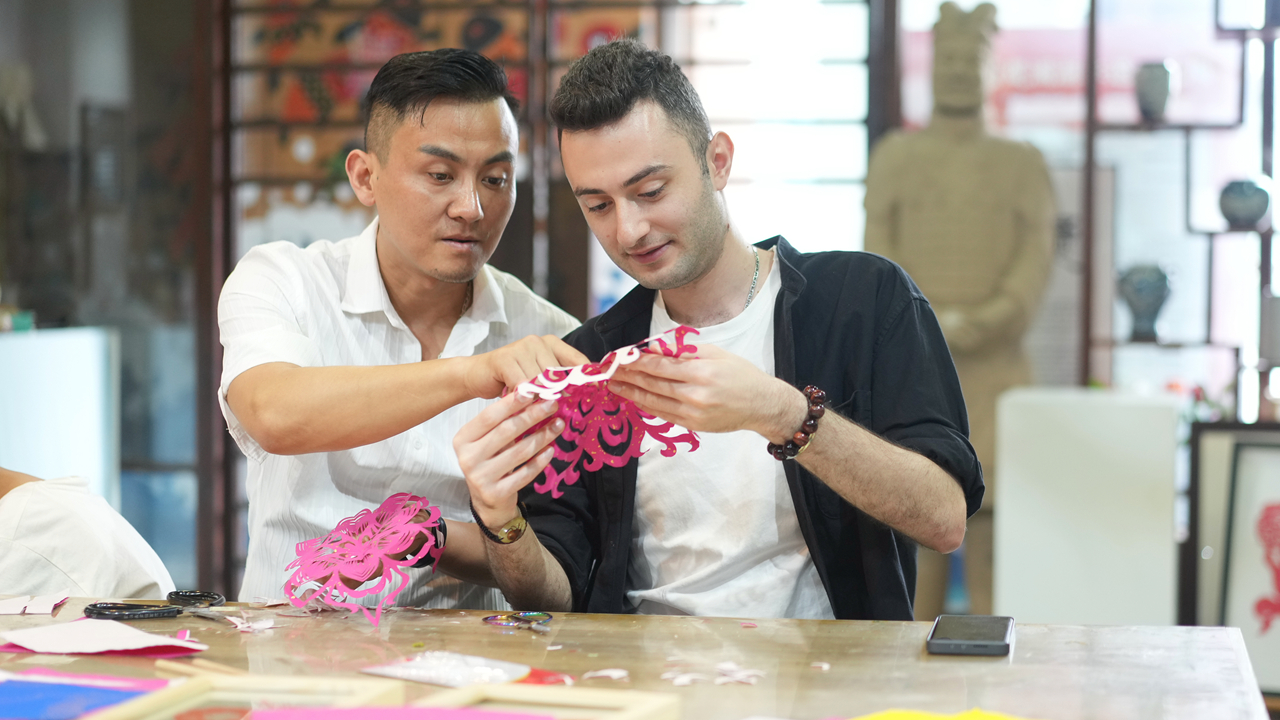Paper cutting is a Chinese folk art with a long history of using simple tools to make beautiful patterns to record people’s lives in ancient time. As a kind of intangible cultural heritage reflecting the history of regional culture and traditional changes, the ancient art has its unique cultural and aesthetic values.

In a modern metropolis such as Shenzhen, there are quite a few intangible cultural heritage promotion centers. One center, located at Mission Hills Maker in Longhua District, promotes Meixian paper cutting, which originated from the expression of good wishes during festive days. It is one of the most popular forms of traditional art showcasing rural folk festival activities in local areas.
Story of heritage inheritor
Wang Ning, an inheritor of Meixian paper cutting, came to Longhua District in 2016 to work full-time on the inheritance of the intangible cultural heritage.
Wang continues to explore new ways to give the traditional art a new life in the modern era. “Traditional paper cutting employs single colors like red paper with white background. I want to give it a new perspective, so I have incorporated different color blocks to make it more appealing to young people.”
To make the works more vivid, Wang uses materials such as special rice paper and cardboard. “The color of the cardboard can change the traditional feature of paper cutting being flat.”
“Every art has its own language and stories, and at first the artist himself should have strong feelings about it before he can influence others,” he said.
Since the establishment of the intangible cultural heritage center at Mission Hills Maker in 2019, Wang has held over 100 public welfare events to promote the traditional art, including giving lectures at schools and hosting workshops for free.
Louay Ali Dib from Syria participated in a workshop hosted by Wang during a warm-up event for the 19th China (Shenzhen) International Cultural Industries Fair (ICIF) on June 3.

“He gave me the feeling that he just loved what he’s doing. When you love what you are doing, you really put so much passion into it. I can feel he’s teaching from his heart,” the Syrian youth said while commenting on Wang’s workshop. “When he gave me those feelings, it was easy for me to follow along what he said. And that made it easier for me to understand and learn it a bit faster,” said Louay, who has shown interest in traditional Chinese arts. Louay, a computer engineer, said he likes the stories from “The Classic of Mountains and Seas,” a Chinese classic compilation of mythic geography and myth.
Techs revive traditional arts
Intangible cultural heritage inheritors like Wang are exploring new ways to make traditional arts more appealing to younger generations.
The theme “How to help traditional arts thrive in the new era?” was a focus on a forum about traditional craftsmanship Saturday at Mission Hills Maker, one of subvenues of ICIF.
Thirteen experts and inheritors discussed topics such as digitization, technology and creativity, emphasizing the importance of preserving cultural heritages while also promoting innovation and industrial upgrading.
Zang Xiaoge, vice dean of the School of New Media Art and Design at Beihang University, cited embroidery of the Kazakh ethnic group as an example and outlined the entire process of using cutting-edge digital technologies to collect, store, display and disseminate traditional craftsmanship as well as promote inheritance and innovation.
Zhu Bingfan, general manager of Guangzhou Wenmu Culture, introduced the application of new technologies in the dissemination of intangible cultural heritages, such as using 3D motion capture technology to record folk dances, martial arts and repair broken unearthed cultural relics, as well as replicating traditional crafts using 3D printing.

According to a Research Report on the Integration and Development of Chinese Handicrafts and Technologies released by Wen Lijun, editor-in-chief of Chinese Handicraft magazine, the vast majority of practitioners believed that the proportion of traditional craftsmanship and new technologies should be 70% and 30%, respectively, to highlight the major roles of traditional craftsmanship.
Unlike practitioners emphasizing the essence of traditional crafts, more consumers support a 50-50 ratio of traditional craftsmanship and technology, the report said.
However, both practitioners and consumers considered “characteristic features” to be the most important for an art product, followed by other features as quality, beauty and functionality.
Wen suggested that traditional craftsmen should be brave enough to exhibit their own “sense of technologies.”
Without written authorization from Longhua District People's Government,the content of the site shall not be republished or used in any form
Technical support hotline: 0755-23332038